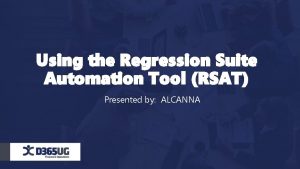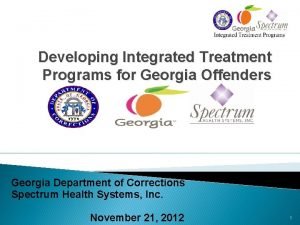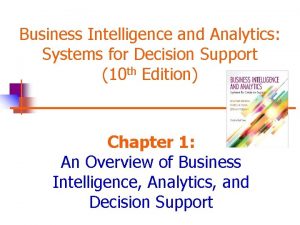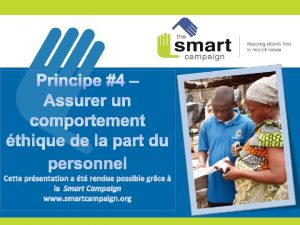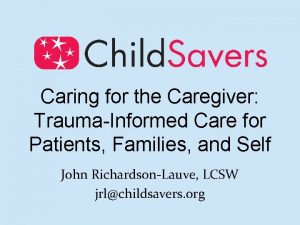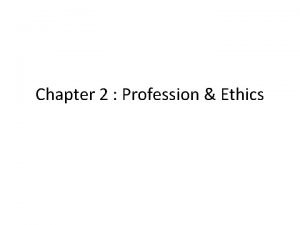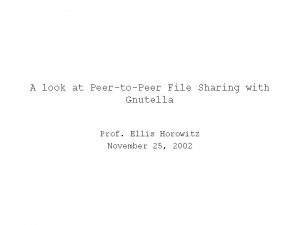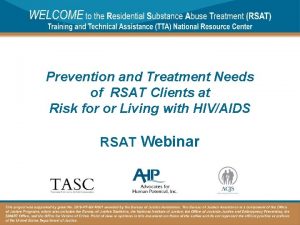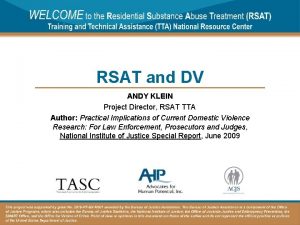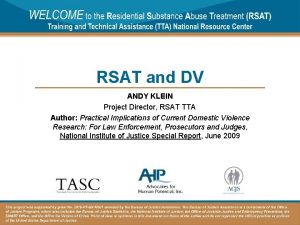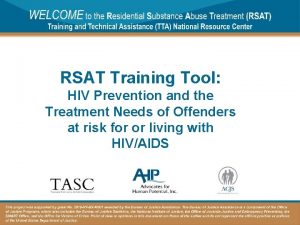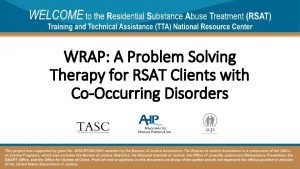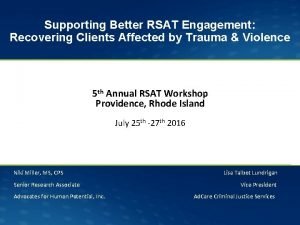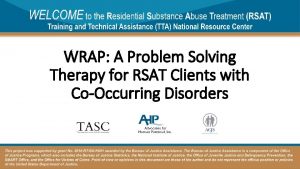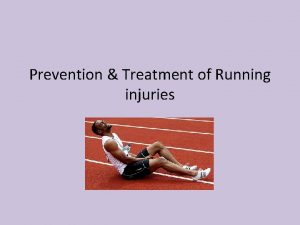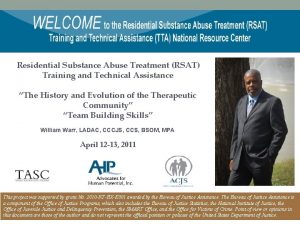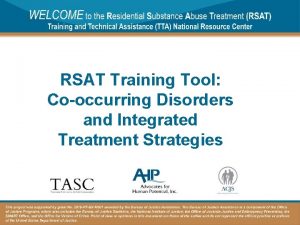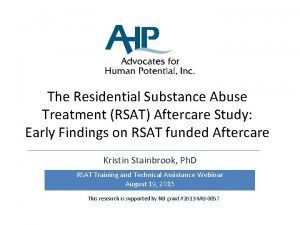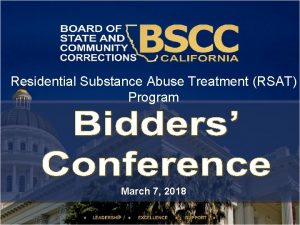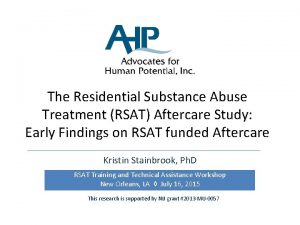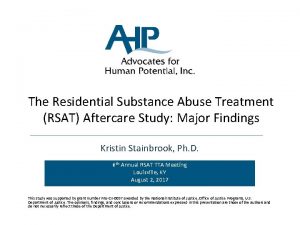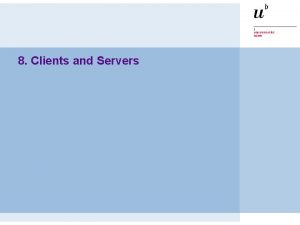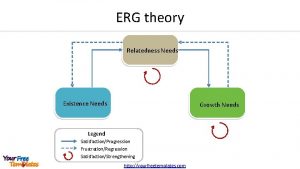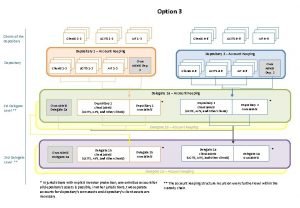Prevention and Treatment Needs of RSAT Clients at




























- Slides: 28

Prevention and Treatment Needs of RSAT Clients at Risk for or Living with HIV/AIDS RSAT Webinar

Prevention and Treatment Needs of Offenders at risk for or living with HIV/AIDS Niki Miller, M. S. CPS Advocates for Human Potential nmiller@ahpnet. com 2/23/2021 2

Who Needs this Information? A lack of information and training, specifically within the correctional workforce, has been identified as a barrier to reducing the spread of HIV. Addiction Professionals Case Managers Mental Health Counselors Volunteers Program Staff Administrators Healthcare Staff 2/23/2021 Security Staff Chaplains Community Corrections 3

Why is early detection so important? Ø Ø One million people are infected with HIV in the US; at least 25% do not know it. Ø Substance use multiplies the risk of HIV infection by 12. The transmission rate is 3. 5 Ø About 40% of AIDS deaths are times higher for those who don’t attributable to drug use. know they are HIV+. Ø 1 in 5 HIV+ individuals in the US pass through correctional facilities each year. 4

Course Objectives Ø Ø Increase knowledge of best practices for preventing, detecting and treating HIV/AIDS in corrections. Enable staff to support HIV screening and meet the SUD treatment needs of at-risk and HIV+ offenders. Increase staff’s ability to modify health risk behaviors, pre and post release, and access re-entry resources. Explain ethical mandates for confidentiality and reporting new cases of HIV, and legal challenges to discriminatory practices and segregation. 2/23/2021 5

Module I HIV/AIDS in Correctional Treatment Settings Ø Ø Ø Basic information on HIV/AIDS, modes of transmission and estimated rates among offenders HIV screening guidelines for corrections and for substance treatment settings Resources, links to training centers, inmate education materials and info on notification procedures 2/23/2021 6

New Guidelines Module I: Research Module I: Ø Ø Centers for Disease Control (CDC) - routine “opt-out” HIV screening in primary care for all 13 -64 years old CDC guidelines for pregnant women, prenatal care and prevention of mother-to-child transmission. The National Commission on Correctional Health Care voluntary, routine, universal screening, informed consent and opt out rights. Center for Substance Abuse Treatment: rapid-testing/ referral to treatment an evidence-based practice 2/23/2021 7

Module I: Priorities for Program Staff Module I: Research Accurate information on preventing transmission Ø Risk reduction interventions modify sex & drug use behavior Convey benefits of knowing their status Ø Today, HIV+ status is far from the death sentence it once was Emotional support Ø Better clients face a difficult diagnosis while in treatment Effective substance use disorder treatment Ø Quality, fidelity and continuing care 2/23/2021 8

Module I: Abstinence Violation at Release Module I: Research Majority are infected before entering correctional systems; small numbers contract HIV in correctional facilities Ø Ø Ø Substance use - predictor of high risk sexual behavior at release Studies show some offenders have unprotected sex and use IV drugs within hours of release Goal: modify post-release drug use and sex high risk behaviors 2/23/2021 9

Ø Ø Ø Module I: Legal Issues in HIV Testing pg. 22 in manual Module I: Research HIV Testing laws for each state State laws specific to testing prison & jail inmates Federal BOP testing guidelines – mandates for high risk inmates National HIV/AIDS Consultation Center: info on state laws; hotline for questions Familiarize staff with facility & state guidelines; align practices accordingly… 2/23/2021 10

Module I: Resource Pages Module I: Research Resource pages (pgs. 20, 40, 58 & 75 ) in the manual can help locate: • State laws on notification • Testing & clinical guidelines for corrections • Guidelines on pregnancy • Federal BOP HIV guidelines • Client and family fact sheets • Training and consultation 2/23/2021 • Hotline number for questions • HIV addiction treatment best practices • HIV evidence-based intervention • HIV/AIDS re-entry resources • Advocacy and legal information • Exposure protocols for staff 11

Module II: HIV in Addiction Treatment Ø Linked to unsafe sexual behaviors; target behaviors for clients Ø HIV testing procedures and types Ø Legal and ethical & counseling practice issues 2/23/2021 12

Module II: Pre and Post-test Counseling Module I: Research Ø Ø Ø Working w/healthcare professionals to provide pre and post test information In correctional settings, inmates may seek pre and posttest counseling from program staff Drug and sex risk reduction messages at each contact Offer testing, info on risk reduction & preventing transmission to others Enable HIV+ persons to inform drug & sex partners 2/23/2021 13

Module II: Types of Tests Module I: Research Ø Ø Ø All HIV testing requires a second confirmation test Rapid test- results within an hour; often best approach to testing of jail inmates; best practice in addiction treatment Conventional test- ELISA looks at antibodies in serum Confirmatory test- usually use Western Blot High risk inmates may benefit from repeating the test in 3 -6 months 2/23/2021 14

Module II: Ø HIV Hepatitis, HIV and IV Drug Use Module I: Research prevention can reduce medical care costs Ø Hepatitis B virus (HBV); Hepatitis C virus (HCV) more easily transmitted; co-infection common. Ø Rates of HCV are epidemic = 10 x the rate of the general public; 33% higher for women offenders. 2/23/2021 15

Module III Meeting the Needs of HIV+ Clients Approaches & treatment needs of HIV+ clients differ at each stage of disease: Ø Anti-retroviral treatment adherence issues Ø Care transitions & re-entry planning for HIV+ offenders Ø Resources for community-based care & housing Ø Complicating medical conditions 2/23/2021 16

Module III: Challenges of Diverse Care Needs Module I: Research Program staff is offender’s source of addiction recovery treatment and support. A team approach ensures they function within the scope of knowledge and training. Case Management Addiction Treatment Medical Care 2/23/2021 Mental Health Treatment Cognitive. Behavioral Treatment HIV+ Inmate Social Skills Training Housing Re-Entry Support 17

Module III: Care Needs at Each Stage Module I: Research HIV+ offenders have many of the same treatment needs as other RSAT clients: support for changing their behavior. But, their circumstance may differ: • • • Offenders who do not disclose their HIV+ status Offenders HIV+ with limited access to care Offenders not yet at the point of needing treatment Offenders for whom treatment is medically indicated Offenders undergoing treatment in the community Offenders with full blown AIDS 2/23/2021 18

Module III: What is HAART? Module I: Research Highly Active Anti-retroviral Therapy. Ø Ø Ø Aggressive medication treatment, consisting of a combination of at least three drugs. Effective for offenders in facilities but, transitions in and out of prisons and jails result in interruption Low adherence to HAART is associated with poor outcomes, including earlier death 2/23/2021 19

Module III: Ø Ø Re-entry and Continuity of Care Module I: Research Long term substance treatment in facilities is significantly more effective when followed up with community treatment The same is true of HIV treatment Connections to community care, resources and a support system are critical needs Re-entering HIV+ offenders best served by leaving with a 30 day supply of meds and an appointment 2/23/2021 20

Module III: Ø Ø Ø The Ryan White CARE Act pg. 58 Module I: Research Reauthorized in 2006 -resources directed toward incarcerated and re-entering HIV+ individuals Housing Opportunities for People living With AIDS (HOPWA)available to offenders if they meet income eligibility AIDS Drug Assistance Program (ADAP)- Administered by states Ø Offenders who begin HAART in correctional tend not to continue once released Ø Those that had help filing an ADAP application were more likely to have medications Ø Low income offenders receive HIV medications 2/23/2021 21

Module IV: Case Histories & HIV/AIDS Special Topics Ø Ø Ø Health literacy and cultural considerations in HIV prevention and treatment Engaging groups of at-risk offenders Issues for underserved: Youth, Women, African Americans, Latinos 2/23/2021 22

Module IV: HIV Issues for Underserved Groups Module I: Research Ø Health disparities profoundly impact HIV outcomes Ø African Americans under represented in research Ø Distrust among much of the Black community regarding HIV, behavioral health services and research. What works? Connect all HIV+ offenders with AIDS Service Organizations and culturally specific community agencies; peer-run education groups 2/23/2021 23

Module IV: Best Practices w/Underserved Groups Good Module I: Research • Use of culturally specific risk reduction interventions from the CDC Better • AIDS Service Organizations or culturally specific community groups deliver these to offenders Best • Have these groups train Latino, African American, females etc. to deliver peer-led groups 2/23/2021 24

Module IV: Examples of Interventions for w/Underserved Groups Module I: Research Project Start–Young men leaving prisons Safer Sex Skills Building-Sexually active women in drug treatment Safe on the Outs–Juvenile detention facilities 2/23/2021 25

Questions Module I: Research Ø Questions, ideas, thoughts or comments? Sincerest thanks for your participation! 2/23/2021 26

RSAT Technical Assistance and Training Center Contact for Niki Miller : 508 -361 -5848 nmiller@ahpnet. com HIV Manual : www. rsat-tta. com/Curricula For more information on RSAT training and technical assistance visit: www. rsat-tta. com/Home Or email Jon Grand, RSAT TA Coordinator : jgrand@ahpnet. com 2/23/2021 27

Next Presentation Choosing and Using Evidence-Based Curricula February 20, 2013 2: 00 – 3: 00 p. m. EST This presentation grapples with two questions: 1. What treatment issues matter most in selecting evidence-based curricula (i. e. , specific EB content and protocols) for one’s program? 2. What matters most for effective implementation of any curricula? These questions loom larger as more EB interventions enter a growing market of tools available to RSAT programs. Without critiquing or ranking specific products, we will focus on: 1. Deciding what your program wants a product to accomplish; 2. Selecting a product with evident capacity to do the job that might also fit well into your program; and, 3. Implementing the curriculum/intervention with both rigor and sensible adaptations. The webinar is for program decision-makers who want to get the most treatment impact from any given EB curriculum. And it’s for treatment staff who must deliver that curriculum and need to somehow make it their own. Presenter: Fred Zackon 2/23/2021 28
 Primary prevention secondary prevention tertiary prevention
Primary prevention secondary prevention tertiary prevention Clients needs assessment
Clients needs assessment D365 rsat
D365 rsat Rsat program in georgia
Rsat program in georgia Patr program utah
Patr program utah Primary needs and secondary needs
Primary needs and secondary needs Primary needs and secondary needs
Primary needs and secondary needs Henry murray theory
Henry murray theory Strategic gender needs and practical gender needs
Strategic gender needs and practical gender needs What are target needs
What are target needs Business intelligence and analytics 10th edition
Business intelligence and analytics 10th edition Web essentials clients servers and communication
Web essentials clients servers and communication Today's public relations departments
Today's public relations departments Recruiter call script to candidate
Recruiter call script to candidate Principe de protection des clients
Principe de protection des clients étude de flux
étude de flux Typologie des clients insatisfaits
Typologie des clients insatisfaits Ibm thin client
Ibm thin client How to schedule appointments with clients
How to schedule appointments with clients Trauma-informed questions for clients
Trauma-informed questions for clients Assessment questions for social workers
Assessment questions for social workers Nudge for clients
Nudge for clients Existential therapy from a multicultural perspective
Existential therapy from a multicultural perspective Standard of care engineering ethics
Standard of care engineering ethics Acting as if adlerian therapy
Acting as if adlerian therapy Counseling multicultural clients
Counseling multicultural clients Using bird dogs when prospecting for clients refers to
Using bird dogs when prospecting for clients refers to Scalp care shampooing and conditioning chapter 15
Scalp care shampooing and conditioning chapter 15 Gnutella file sharing
Gnutella file sharing


